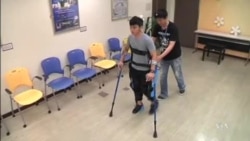Powered suits that could help paralyzed people walk and others lift and carry heavy loads with ease have been an inventor's dream since late 19th century. But they had to wait until the 21st century for the advanced materials, motors and power sources to bring them closer to practical use.
Now, with the press of a button, a person with a with severe spinal cord injury can have the ability to walk again, thanks to the Walking Assistive Exoskeleton Robot.
The 20-kilogram device, made of aluminum and carbon fiber, has four battery-powered motors that can run for up to three hours. Inventor Wu Cheng-hua, from Taiwan’s Industrial Technology Research Institute, said it had performed successfully in tests on 12 patients.
“We have learned from our research process that patients whose injuries [are] below the fourth chest joint are able to use our robot to stand, walk and sit down,” he said.
Since walking contributes to muscle exercise, Wu said patients received some additional benefits by using his device.
“In the clinical process, we would check their bone mineral density, and we found that the bone mineral densities of these patients had been improved, which is a positive index for their health,” he said.
Wu said his exoskeleton might be available for consumers by 2018.
Meanwhile, baggage handlers at Tokyo’s Haneda Airport will soon start testing a similar device, developed by the Japanese firm Cyberdyne.
When a person wearing the exoskeleton called HAL bends to lift a heavy object, the machine detects the movement, said developer Yoshiyuki Sankai, who is the CEO of Cyberdyne.
“This robot suit detects the signal from the human nerve system to support the waist's movement," Sankai said. "It self-adjusts the level of support it provides to reduce the load on the human waist, while being very light and compact."
The battery-powered device weighs only 3 kilograms and can run for up to three hours. During next six months, Haneda Airport will test three exoskeletons as well as several small cleaning and baggage transport robots.










